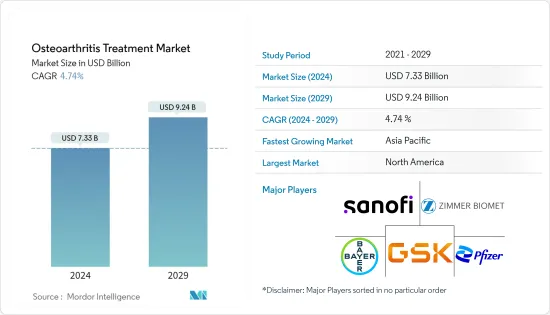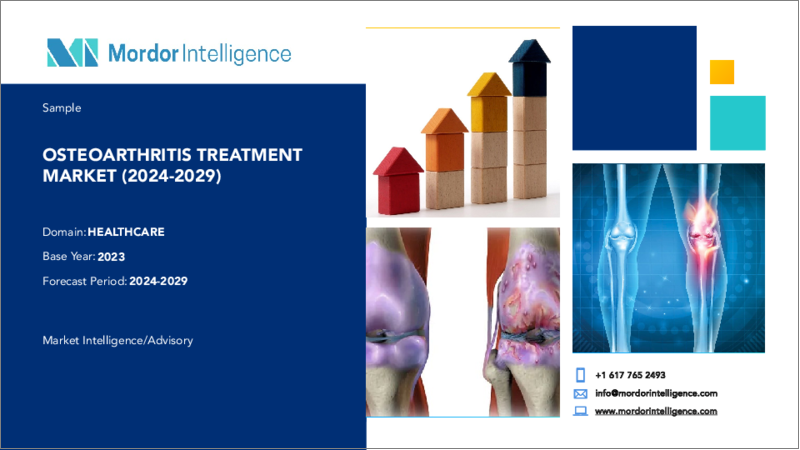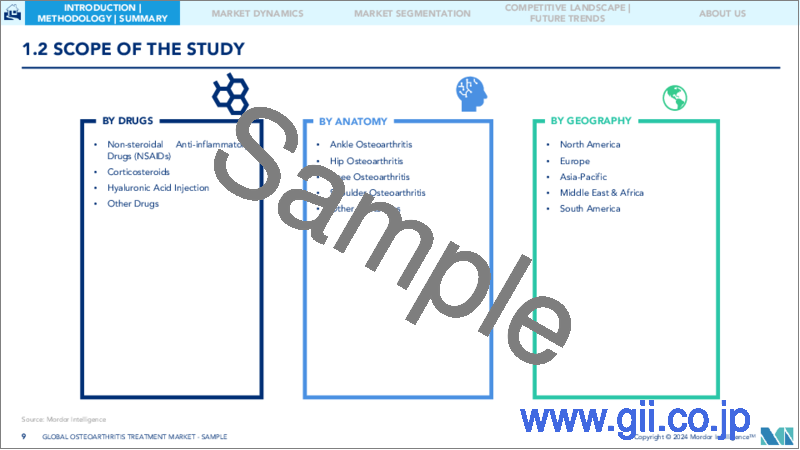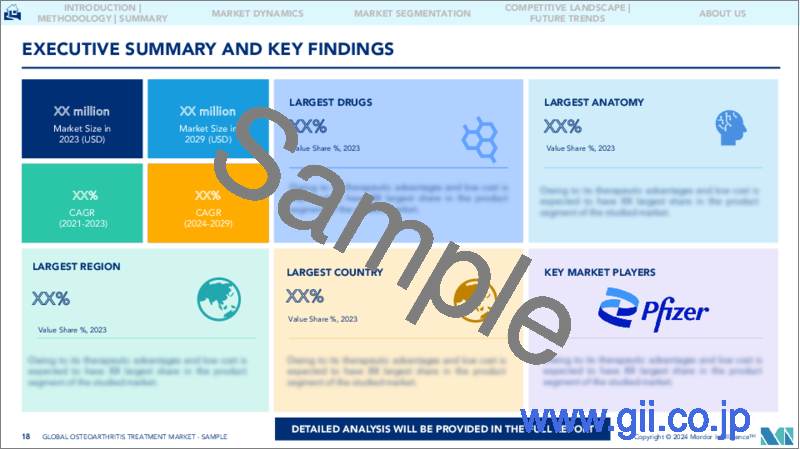|
|
市場調査レポート
商品コード
1437921
変形性関節症治療:市場シェア分析、業界動向と統計、成長予測(2024-2029)Osteoarthritis Treatment - Market Share Analysis, Industry Trends & Statistics, Growth Forecasts (2024 - 2029) |
||||||
カスタマイズ可能
適宜更新あり
|
|||||||
| 変形性関節症治療:市場シェア分析、業界動向と統計、成長予測(2024-2029) |
|
出版日: 2024年02月15日
発行: Mordor Intelligence
ページ情報: 英文 120 Pages
納期: 2~3営業日
|
- 全表示
- 概要
- 目次
変形性関節症治療市場規模は、2024年に73億3,000万米ドルと推定され、2029年までに92億4,000万米ドルに達すると予測されており、予測期間(2024年から2029年)中に4.74%のCAGRで成長します。

新型コロナウイルス感染症(COVID-19)のパンデミックは、予定されていた治療処置のキャンセルまたは延期、変形性関節症の新規診断数の減少につながり、市場の成長に短期的な影響を及ぼしました。 2022年6月にPubMed Centralが発表した論文によると、チェコ共和国では新型コロナウイルス感染症(COVID-19)のパンデミック中に、整形外科患者や外傷患者のヘルスケアが大幅に減少したといいます。外来治療や入院治療を含むヘルスケア制度の欠陥も強調しました。また、COVID-19は、変形性関節症の治療法を含む世界中のいくつかの新しい治療法の臨床試験の遅延に伴い、製薬会社の研究開発活動に影響を与えました。したがって、COVID-19感染症のパンデミックは当初、市場に大きな影響を与えました。しかし、COVID-19感染症の感染者数が減少するにつれ、調査対象となった市場は再び勢いを取り戻し始めています。研究の予測期間中に健全な成長が見込まれます。
高齢者人口の増加、研究開発活動の増加、変形性関節症治療薬への資金提供が、調査対象市場の成長を促進する重要な要因です。
高齢者は変形性関節症になりやすいため、世界の高齢者人口の増加は調査対象市場に大きな影響を与えると予想されます。例えば、国連が2022年に発表したデータによると、世界の65歳以上の人口は2022年の10%から2050年には16%に増加すると予測されています。また、この情報源は、2050年までに65歳以上の人口が減少するとも主張しています。世界中で5歳未満の子どもの数の2倍以上、12歳未満の子どもの数とほぼ同じになると予測されています。さらに、2022年9月にPubMed Centralが発表した論文によると、変形性関節症は障害の重大な原因となっています。これは最も一般的なタイプの関節炎であり、60歳以上の世界人口のほぼ10%が罹患しています。したがって、高齢者人口の増加と高齢者と変形性関節症の関連により、予測期間中の市場の成長が促進されます。
また、人々の意識の高まり、より良い治療選択肢の利用可能性、治療に対する意欲が、変形性関節症治療市場の成長を補完すると予想されます。たとえば、変形性関節症(OA)アクションアライアンスによると、5月は関節炎啓発月間です。また、変形性関節症(OA)が関節炎の最も一般的な形態であるとも述べています。
さらに、市場関係者は、製品の発売、開発、買収と合併、コラボレーションなどのさまざまな戦略を採用し、調査対象の市場で製品ポートフォリオを拡大し、市場を後押ししています。たとえば、2021年 9月、インドの製薬会社Lupine Limitedは、米国で関節リウマチと変形性関節症の症状の治療に使用されるジェネリック Duexis錠剤を発売しました。
したがって、高齢者人口の増加、変形性関節症に対する意識の高まり、製品の発売などの要因により、調査対象の市場は分析期間中に成長すると予想されます。ただし、変形性関節症治療のためのヒアルロン酸製品やその他の治療法に関連する高額なコストと、利用可能な治療法に関連する副作用により、予測期間中の変形性関節症治療市場の成長が妨げられる可能性があります。
変形性関節症治療市場の動向
変形性膝関節症治療薬は、予測期間中に変形性膝関節症治療市場で大きなシェアを握ると予想される
変形性膝関節症は、世界中の人々の老年期における障害の主な原因の1つです。変形性膝関節症の有病率の増加、変形性膝関節症に対する意識の高まり、および高齢者人口の増加は、この分野の成長を担う重要な要因です。たとえば、2022年 6月にPubMed Centralによって発表された論文によると、変形性膝関節症(OA)は変形性関節疾患であり、米国で膝関節置換術が行われる最も一般的な理由の1つです。したがって、治療のための治療薬の必要性が生まれ、市場セグメントの成長を促進します。
2022年のOECDデータによると、オーストラリアの高齢者人口は2021年に16.82%に増加し、他の年と比べて高くなりました。同様に、同じ情報源によると、ドイツの高齢者人口は2021年に22.09%に増加しました。変形性膝関節症は高齢との関連性が高いため、高齢者人口の増加もこのセグメントの成長を補うと予想されます。
さらに、市場の主要企業による継続的な発展は、この部門の成長にプラスの影響を与えています。たとえば、2021年9月にノバルティスは、変形性膝関節症を治療するためのLNA043について米国FDAから承認を取得しました。 LNA043は、変形性関節症(OA)に対するファーストインクラスの疾患修飾治療法の候補として開発されています。
したがって、変形性膝関節症セグメントは、変形性膝関節症の有病率の増加、さまざまな国での高齢者人口の増加、主要企業による継続的な開発により、予測期間中に大幅な成長を遂げると予想されます。
北米は予測期間中に変形性関節症治療市場で大きなシェアを獲得すると予想される
北米市場は、慢性疾患の増加、高齢者人口の増加、人々の生活ライフスタイルの変化により、今後の成長が見込まれています。その結果、この地域ではさまざまな治療法や薬剤の採用が増加しています。米国は、カナダやメキシコと比較して、北米の変形性関節症治療市場で大きなシェアを握ることになります。 Osteoarthritis Action Allianceによって更新された、2020年変形性関節症に関する国家公衆衛生アジェンダ報告書によると、変形性関節症は関節炎の最も一般的な形態です。米国では成人 7人に1人、約3,250万人が罹患しており、そのうち変形性関節症成人の50%以上が就労年齢です。したがって、この地域における変形性関節症の有病率の高さは、調査対象市場の成長を促進すると予想されます。
さらに、カナダとメキシコにおける変形性関節症の有病率の上昇も市場の成長を推進しています。たとえば、カナダ関節炎協会が2021年 9月に発表したデータによると、400万人以上のカナダ人が変形性関節症を患っていると推定されており、これは他のすべての種類の関節炎を合わせた数よりも多いです。また、カナダの成人の約7人に1人が変形性関節症の影響を受けながら生きていると推定されています。さらに、PubMed Centralが2022年1月に発表した論文によると、メキシコにおける症候性変形性膝関節症の有病率は18歳以上で7.1%、40歳以上で17.6%であることが研究で示されました。したがって、カナダとメキシコでの変形性関節症の有病率の増加に伴い、調査対象市場は調査の予測期間中に成長すると予想されます。
さらに、より良い治療選択肢の利用可能性、政府の償還政策、新しい治療法の開発における研究開発活動の増加、北米地域での新しい治療法の発売も市場の成長を後押しすると予想されます。例えば、2022年1月、メルクは子会社のアレス・トレーディングSAを通じて、米国のTrialSpark/High Line Bioとスプリファーミンのライセンスアウト契約を締結しました。スプリフェルミンは、変形性関節症(OA)患者を対象として現在研究されているヒト線維芽細胞成長因子 18の組換え型です。
したがって、高齢者人口の増加、変形性関節症の有病率の上昇、新規治療薬の開発における研究開発活動の増加、新しい治療薬の発売などの要因により、北米地域は調査対象市場において世界全体に比べて大きなシェアを握ると予想されています。
その他の特典
- エクセル形式の市場予測(ME)シート
- 3か月のアナリストサポート
目次
第1章 イントロダクション
- 調査の前提条件と市場の定義
- 調査範囲
第2章 調査手法
第3章 エグゼクティブサマリー
第4章 市場力学
- 市場概要
- 市場促進要因
- 高齢者人口の増加
- 変形性関節症治療のための研究開発活動と資金提供の増加
- 市場抑制要因
- 治療に伴う高額な費用
- 利用可能な治療法に伴う副作用
- ポーターのファイブフォース分析
- 供給企業の交渉力
- 買い手の交渉力
- 新規参入業者の脅威
- 代替製品の脅威
- 競争企業間の敵対関係の激しさ
第5章 市場セグメンテーション
- 薬物別
- 非ステロイド性抗炎症薬(NSAID)
- コルチコステロイド
- ヒアルロン酸注射
- その他の薬物
- 解剖学別
- 変形性足首関節症
- 変形性股関節症
- 変形性膝関節症
- 変形性肩関節症
- その他の解剖学
- 地域
- 北米
- 米国
- カナダ
- メキシコ
- 欧州
- ドイツ
- 英国
- フランス
- イタリア
- スペイン
- その他欧州
- アジア太平洋
- 中国
- 日本
- インド
- オーストラリア
- 韓国
- その他アジア太平洋地域
- 中東とアフリカ
- GCC
- 南アフリカ
- その他中東およびアフリカ
- 南米
- ブラジル
- アルゼンチン
- その他南米
- 北米
第6章 競合情勢
- 企業プロファイル
- Bayer AG
- OrthogenRx
- Abbott Laboratories
- Glaxosmithkline plc
- Sanofi SA
- Pfizer Inc.
- Zimmer Biomet
- Anika Therapeutics Inc.
- Viatris
- Novartis AG
- SEIKAGAKU CORPORATION
- Assertio Holdings Inc.
第7章 市場機会と将来の動向
The Osteoarthritis Treatment Market size is estimated at USD 7.33 billion in 2024, and is expected to reach USD 9.24 billion by 2029, growing at a CAGR of 4.74% during the forecast period (2024-2029).

The COVID-19 pandemic had a short-term impact on the market growth as it led to the cancelation or postponement of the scheduled treatment procedures and a decrease in the number of new diagnoses of osteoarthritis. According to the article published by PubMed Central in June 2022, there was a significant reduction in the healthcare of orthopedic and trauma patients during the COVID-19 pandemic in the Czech Republic. It also emphasized the healthcare system's shortcomings, including outpatient and inpatient care. Also, COVID-19 impacted pharmaceutical companies' research and development activities along with the delay in clinical trials of several new therapies worldwide, including treatments for osteoarthritis. Hence, the COVID-19 pandemic had a significant impact on the market initially. However, as the number of cases of COVID-19 has declined, the studied market has started to regain traction. It is expected to have healthy growth during the forecast period of the study.
The increasing geriatric population, increasing research & development activities, and funding for osteoarthritis therapeutics are the significant factors driving the growth of the studied market.
As the older population is more susceptible to osteoarthritis, the increase in the global geriatric population is expected to have a significant impact on the studied market. For instance, according to the data published by the UN in 2022, the global population aged 65 years or above is projected to rise from 10% in 2022 to 16% in 2050. The source also claims by 2050, the number of people aged 65 years or over worldwide is projected to be more than twice the number of children under age five and about the same as the children under age 12. Furthermore, according to an article published by PubMed Central in September 2022, osteoarthritis is a significant cause of disability. It is the most common type of arthritis, affecting almost 10% of the global population aged 60 years and above. Hence, the rising geriatric population and the association of old age with osteoarthritis will enhance the market growth during the forecast period.
Also, the increasing awareness among the people, the availability of better treatment options, and the willingness to take up treatment are expected to complement the growth of the osteoarthritis treatment market. For instance, according to the Osteoarthritis (OA) Action Alliance, May is arthritis awareness month. It also stated that osteoarthritis (OA) is the most common form of arthritis.
Additionally, the market players have been adopting various strategies, such as product launches, developments, acquisitions and mergers, and collaborations, and expanding their product portfolio in the studied market and boosting it. For instance, in September 2021, Indian drug manufacturer Lupin Limited launched generic Duexis tablets used to treat the symptoms of rheumatoid arthritis and osteoarthritis in the US.
Therefore, owing to the factors such as the increasing geriatric population, increasing awareness about osteoarthritis, and product launches, the studied market is anticipated to witness growth over the analysis period. However, the high cost associated with hyaluronic acid products and other treatment procedures for osteoarthritis treatment and the side effects related to the available therapies may impede the growth of the osteoarthritis treatment market over the forecast period.
Osteoarthritis Treatment Market Trends
Knee Osteoarthritis Therapeutics is Expected to Hold a Significant Share in the Osteoarthritis Treatment Market Over the Forecast Period
Knee osteoarthritis is one of the primary reasons for disability in old age in people all over the world. The increasing prevalence of knee osteoarthritis, increasing awareness about knee osteoarthritis, and the rising geriatric population are vital factors responsible for the segment's growth. For instance, according to the article published by PubMed Central in June 2022, knee osteoarthritis (OA) is a degenerative joint disease, one of the most common reasons for knee joint replacements in the US. Thus, it creates the need for therapeutic drugs for treatment and drives the market segment's growth.
As per the OECD data in 2022, the elderly population in Australia has increased to 16.82% in 2021, which is high compared to other years. Similarly, according to the same source, the elderly population in Germany increased to 22.09% in 2021. As knee osteoarthritis is highly associated with old age, the increasing geriatric population is also expected to complement the segment growth.
Furthermore, continuous developments by major players in the market are positively affecting the segment's growth. For instance, in September 2021, Novartis received approval from the US FDA for LNA043 to treat knee osteoarthritis. LNA043 is being developed as a potential first-in-class disease-modifying treatment for osteoarthritis (OA).
Therefore, the knee osteoarthritis segment is expected to witness significant growth over the forecast period due to the increasing prevalence of knee osteoarthritis, the rising geriatric population in various countries, and continuous developments by major players.
North America is Expected to Acquire Significant Share in the Osteoarthritis Treatment Market Over the Forecast Period
The North American market is expected to grow, owing to the increasing prevalence of chronic diseases, the rise in the geriatric population, and changes in the living lifestyles of people. As a result, the region's adoption of different treatments and drugs is increasing. The US will hold a significant share of the osteoarthritis treatment market in North America compared to Canada and Mexico. According to the National Public Health Agenda report for Osteoarthritis 2020, updated by the Osteoarthritis Action Alliance, osteoarthritis is the most common form of arthritis. It affects 1 in 7 adults in the US, and about 32.5 million people, from which more than 50% of adults with osteoarthritis are working age. Hence, the high prevalence of osteoarthritis in the region is expected to enhance the growth of the studied market.
Furthermore, the rising prevalence of osteoarthritis in Canada and Mexico is also driving the market's growth. For instance, according to the data published by the Arthritis Society Canada in September 2021, it is estimated more than 4 million Canadians have osteoarthritis, more than all other arthritis types combined. It is also estimated that about 1 in 7 Canadian adults live with the impact of osteoarthritis. Moreover, according to an article published by PubMed Central in January 2022, a study showed that the prevalence of symptomatic knee osteoarthritis was 7.1% in people over 18 years of age and 17.6% among those more than 40 years of age in Mexico. Hence, with the increasing prevalence of osteoarthritis in Canada and Mexico, the studied market is expected to experience growth during the forecast period of the study.
Additionally, the availability of better treatment options, government reimbursement policies, increasing research and development activities in developing novel therapeutics, and launching new therapies in the North American region are also expected to boost the market growth. For instance, in January 2022, Merck, through its subsidiary Ares Trading SA entered into an out-licensing agreement for sprifermin with TrialSpark/High Line Bio of the US. Sprifermin is a recombinant form of human fibroblast growth factor 18 currently being investigated in patients with osteoarthritis (OA).
Hence, due to factors such as the increasing geriatric population, rising osteoarthritis prevalence, increasing research and development activities in developing novel therapeutics, and the launch of new therapies, the North American region is expected to hold a significant share in the studied market over the forecast period.
Osteoarthritis Treatment Industry Overview
The osteoarthritis treatment market is slightly competitive, with several global players actively involved in developing new and advanced therapies for the treatment of osteoarthritis or involved in acquisitions or collaboration agreements to make advancements in the studied market. Some key players in the studied market comprise Sanofi SA, Pfizer Inc., GlaxoSmithKline plc, Zimmer Biomet, Abbott Laboratories, Bayer AG, and Anika Therapeutics, among others.
Additional Benefits:
- The market estimate (ME) sheet in Excel format
- 3 months of analyst support
TABLE OF CONTENTS
1 INTRODUCTION
- 1.1 Study Assumptions and Market Definition
- 1.2 Scope of the Study
2 RESEARCH METHODOLOGY
3 EXECUTIVE SUMMARY
4 MARKET DYNAMICS
- 4.1 Market Overview
- 4.2 Market Drivers
- 4.2.1 Increasing Geriatric Population
- 4.2.2 Increasing Research & Development Activities and Funding for Osteoarthritis Therapeutics
- 4.3 Market Restraints
- 4.3.1 High Cost Associated with the Treatment Procedures
- 4.3.2 Side Effects Associated with the Available Therapeutics
- 4.4 Porter' s Five Forces Analysis
- 4.4.1 Bargaining Power of Suppliers
- 4.4.2 Bargaining Power of Buyers/Consumers
- 4.4.3 Threat of New Entrants
- 4.4.4 Threat of Substitute Products
- 4.4.5 Intensity of Competitive Rivalry
5 MARKET SEGMENTATION (Market Size by Value - USD million)
- 5.1 By Drugs
- 5.1.1 Non-steroidal Anti-inflammatory Drugs (NSAIDs)
- 5.1.2 Corticosteroids
- 5.1.3 Hyaluronic Acid Injection
- 5.1.4 Other Drugs
- 5.2 By Anatomy
- 5.2.1 Ankle Osteoarthritis
- 5.2.2 Hip Osteoarthritis
- 5.2.3 Knee Osteoarthritis
- 5.2.4 Shoulder Osteoarthritis
- 5.2.5 Other Anatomies
- 5.3 Geography
- 5.3.1 North America
- 5.3.1.1 United States
- 5.3.1.2 Canada
- 5.3.1.3 Mexico
- 5.3.2 Europe
- 5.3.2.1 Germany
- 5.3.2.2 United Kingdom
- 5.3.2.3 France
- 5.3.2.4 Italy
- 5.3.2.5 Spain
- 5.3.2.6 Rest of Europe
- 5.3.3 Asia-Pacific
- 5.3.3.1 China
- 5.3.3.2 Japan
- 5.3.3.3 India
- 5.3.3.4 Australia
- 5.3.3.5 South Korea
- 5.3.3.6 Rest of Asia-Pacific
- 5.3.4 Middle East and Africa
- 5.3.4.1 GCC
- 5.3.4.2 South Africa
- 5.3.4.3 Rest of Middle East and Africa
- 5.3.5 South America
- 5.3.5.1 Brazil
- 5.3.5.2 Argentina
- 5.3.5.3 Rest of South America
- 5.3.1 North America
6 COMPETITIVE LANDSCAPE
- 6.1 Company Profiles
- 6.1.1 Bayer AG
- 6.1.2 OrthogenRx
- 6.1.3 Abbott Laboratories
- 6.1.4 Glaxosmithkline plc
- 6.1.5 Sanofi SA
- 6.1.6 Pfizer Inc.
- 6.1.7 Zimmer Biomet
- 6.1.8 Anika Therapeutics Inc.
- 6.1.9 Viatris
- 6.1.10 Novartis AG
- 6.1.11 SEIKAGAKU CORPORATION
- 6.1.12 Assertio Holdings Inc.






